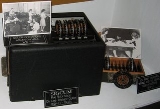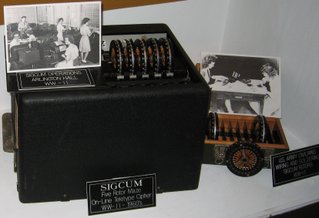
SIGCUM
Encyclopedia

Rotor machine
In cryptography, a rotor machine is an electro-mechanical device used for encrypting and decrypting secret messages. Rotor machines were the cryptographic state-of-the-art for a prominent period of history; they were in widespread use in the 1920s–1970s...
used to encrypt teleprinter
Teleprinter
A teleprinter is a electromechanical typewriter that can be used to communicate typed messages from point to point and point to multipoint over a variety of communication channels that range from a simple electrical connection, such as a pair of wires, to the use of radio and microwave as the...
traffic by the United States Army
United States Army
The United States Army is the main branch of the United States Armed Forces responsible for land-based military operations. It is the largest and oldest established branch of the U.S. military, and is one of seven U.S. uniformed services...
. Hastily designed by William Friedman and Frank Rowlett
Frank Rowlett
Frank Byron Rowlett was an American cryptologist.Rowlett was born in Rose Hill, Virginia and attended Emory & Henry College in Emory, Virginia, where he was a member of the Beta Lambda Zeta fraternity. In 1929 he received a bachelor's degree in mathematics and chemistry...
, the system was put into service in January 1943 before any rigorous analysis of its security had taken place. SIGCUM was subsequently discovered to be insecure by Rowlett, and was immediately withdrawn from service. The machine was redesigned to improve its security, reintroduced into service by April 1943, and remained in use until the 1960s.
Development
In 1939, Friedman and Rowlett worked on the problem of creating a secure teleprinter encryption system. They decided against using a tape-based system, such as those proposed by Gilbert VernamGilbert Vernam
Gilbert Sandford Vernam was an AT&T Bell Labs engineer who, in 1917, invented the stream cipher and later co-invented the one-time pad cipher. Vernam proposed a teleprinter cipher in which a previously-prepared key, kept on paper tape, is combined character by character with the plaintext message...
, and instead conceived of the idea of generating a stream of five-bit pulses by use of wired rotors. Because of lack of funds and interest, however, the proposal was not pursued any further at that time. This changed with the United States' entry into World War II
World War II
World War II, or the Second World War , was a global conflict lasting from 1939 to 1945, involving most of the world's nations—including all of the great powers—eventually forming two opposing military alliances: the Allies and the Axis...
in December 1941. Rowlett was assigned to develop a teleprinter encryption system for use between Army command centers in United Kingdom and Australia (and later in North Africa).
Friedman described to Rowlett a concrete design for a teleprinter cipher machine that he had invented. However, Rowlett discovered some flaws in Friedman's proposed circuitry that showed the design to be flawed. Under pressure to report to a superior about the progress of the machine, Friedman responded angrily, accusing Rowlett of trying to destroy his reputation as a cryptanalyst. After Friedman calmed down, Rowlett proposed some designs for a replacement machine based on rotors. They settled on one, and agreed to write up a complete design and have it reviewed by another cryptanalyst by the following day.
The design agreed upon was a special attachment for a standard teleprinter. The attachment used a stack of five 26-contact rotors, the same as those used in the SIGABA
SIGABA
In the history of cryptography, the ECM Mark II was a cipher machine used by the United States for message encryption from World War II until the 1950s...
, the highly secure US off-line cipher machine. Each time a key character was needed, thirteen inputs to the rotor stack were energized at the input endplate. Passing through the rotor stack, these thirteen inputs were to be scrambled at the output endplate. However, only five live contacts would be used. These five outputs would form five binary impulses, which would form the keystream
Keystream
In cryptography, a keystream is a stream of random or pseudorandom characters that are combined with a plaintext message to produce an encrypted message ....
for the cipher, to be combined with the message itself, encoded in the 5-bit Baudot code
Baudot code
The Baudot code, invented by Émile Baudot, is a character set predating EBCDIC and ASCII. It was the predecessor to the International Telegraph Alphabet No 2 , the teleprinter code in use until the advent of ASCII. Each character in the alphabet is represented by a series of bits, sent over a...
.
The rotors advanced odometrically; that is, after each encipherment, the "fast" rotor would advance one step. Once every 26 revolutions of the fast rotor, the "medium" rotor would step once. Similarly, ever 26 revolutions of the medium rotor, the "slow" rotor would step, and so on for the other two rotors. However, which rotor was assigned as the "fast", "medium", "slow" etc rotors was controlled by a set of five multi-switches. This gave a total of
 different rotor stepping patterns. The machine was equipped with a total of 10 rotors, each of which could be inserted "direct" or in reversed order, yielding
different rotor stepping patterns. The machine was equipped with a total of 10 rotors, each of which could be inserted "direct" or in reversed order, yielding  possible rotor orderings and alignments.
possible rotor orderings and alignments.Introduction of the machine
The design for this machine, which was designated the Converter M-228, or SIGCUM, was given to the Teletype CorporationTeletype Corporation
The Teletype Corporation, a part of American Telephone and Telegraph Company's Western Electric manufacturing arm since 1930, came into being in 1928 when the Morkrum-Kleinschmidt Company changed its name to the name of its trademark equipment...
, who were also producing SIGABA
SIGABA
In the history of cryptography, the ECM Mark II was a cipher machine used by the United States for message encryption from World War II until the 1950s...
. Rowlett recommended that the adoption of the machine be postponed until after a study of its cryptographic security, but SIGCUM was urgently needed by the Army, and the machine was put into production. Rowlett then proposed that the machine used in the Pentagon code room be monitored by connecting a page-printing "spy machine". The output could be then studied to establish whether the machine was resistant to attack. Rowlett's suggestion was implemented at the same time the first M-228 machines were installed at the Pentagon in January 1943, used for the Washington
Washington, D.C.
Washington, D.C., formally the District of Columbia and commonly referred to as Washington, "the District", or simply D.C., is the capital of the United States. On July 16, 1790, the United States Congress approved the creation of a permanent national capital as permitted by the U.S. Constitution....
-Algiers
Algiers
' is the capital and largest city of Algeria. According to the 1998 census, the population of the city proper was 1,519,570 and that of the urban agglomeration was 2,135,630. In 2009, the population was about 3,500,000...
link.
The machines worked as planned, and, initially, Rowlett's study of its security, joined by cryptanalyst Robert Ferner, uncovered no signs of cryptographic weakness. However, after a few days, a SIGCUM operator made a serious operating error, retransmitting the same message twice using the same machine settings, producing a depth.
From this, Rowlett was able to deduce the underlying plaintext
Plaintext
In cryptography, plaintext is information a sender wishes to transmit to a receiver. Cleartext is often used as a synonym. Before the computer era, plaintext most commonly meant message text in the language of the communicating parties....
and keystream used by the machine. By 2 a.m., an analysis of the keystream allowed him to deduce the wiring of the fast and medium rotors, and of the output wiring. SIGCUM was immediately withdrawn from service, and work on a replacement system, SIGTOT — a one-time tape machine designed by Leo Rosen
Leo Rosen
Leo Rosen was a U.S. cryptanalyst who worked with Frank Rowlett at Signals Intelligence Service before the start of World War II on Japanese ciphers. Rowlett found a method to read the messages enciphered on the Japanese PURPLE machine...
— was given top priority.
Redesign
Meanwhile, M-228 was redesigned to improve its security. Only five inputs, rather than thirteen, were energized. The five output contacts, instead of being used as the five output bits directly, were instead connected by three leads, each connected to different output point. That meant that an output bit could be energized by any of three different outputs from the rotor maze, making analysis of the machine more complex. The reduced number of inputs ensured that the generated key would not be biased.The rotor stepping was also made more complex. The slowest two rotors, which originally were unlikely to step during the course of an encipherment, were redesigned so that they stepped depending on the output of the previous key output. One rotor, designated that "fast bump" rotor, would step if the fourth and fifth bits of the previous output were both true; and similarly the "slow bump" rotor would do the same for the first, second and third bits.
Certain of the rotor stepping arrangements were discovered to be weaker than others, and so these were ruled out for key lists.
This redesigned version of the M-228 was put into service by April 1943. However, the machine was judged to be secure enough to handle traffic only up to SECRET by landline, and to CONFIDENTIAL by radio. The machine was also shared with the United Kingdom for joint communications.
A further-modified version of the M-228 could be used for the highest level traffic, designated M-228-M, or SIGHUAD.
From that point on, the Army monitored the communications of its high-level systems to ensure that good operational procedure was being followed, even for highly secure devices such as the SIGABA and SIGTOT devices. As a result, poor operator practices, such as transmitting messages in depth, were largely eliminated.
External links
- Converter M-228 or SIGCUM by John Savard

